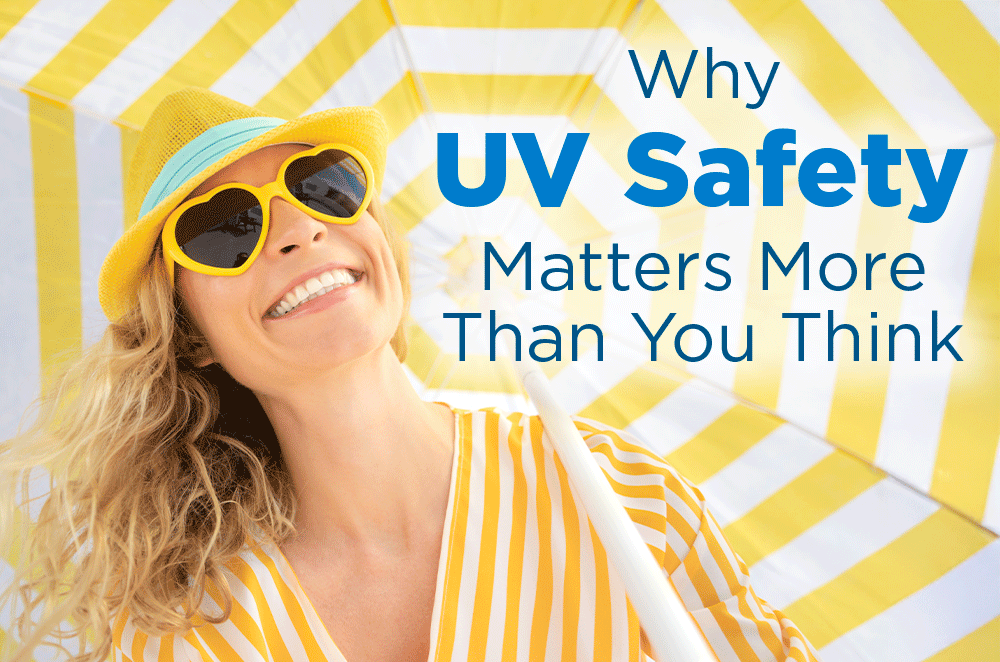As the sun shines brighter and the days get longer here in Oklahoma, it’s natural to think about enjoying the great outdoors. And, given that, July being UV Safety Month, it’s the perfect time to shine a spotlight on something really important for your health!
While we all know that too much sun can lead to a painful sunburn, have you ever stopped to consider what’s happening beneath the surface, long after that redness fades?
At Comanche County Memorial Hospital, we want to keep our community healthy, and that means looking beyond the sunburn. When it comes to UV (ultraviolet) radiation from the sun, those long-term effects are far more serious than just a temporary discomfort. So, let’s talk about why consistent UV safety is a year-round commitment for your health.
The Unseen Damage
That “healthy glow” we sometimes chase is actually a sign of your skin trying to protect itself from damage. Consequently, over time, repeated sun exposure, even without a noticeable burn, can lead to some significant health concerns.
Skin Cancer
First and foremost, let’s discuss skin cancer. This is, without a doubt, the most serious long-term effect of UV radiation. Basal cell carcinoma and squamous cell carcinoma are the most common types, often appearing on sun-exposed areas like your face, neck, and hands. Beyond these, there’s melanoma, the most aggressive and potentially deadliest form of skin cancer. UV rays directly damage the DNA in your skin cells, which can lead to uncontrolled growth. The good news? When caught early, skin cancers are often highly treatable. Therefore, being aware and proactive is so vital!
Premature Aging
Furthermore, fine lines and wrinkles are a hallmark of sun-damaged skin, but it goes deeper than that. UV radiation breaks down collagen and elastin, the proteins that keep your skin firm and smooth. Ultimately, this leads to a loss of elasticity, sunspots (also called age spots or hyperpigmentation), and a leathery texture. Believe it or not, up to 90% of the visible changes we typically associate with aging are actually caused by the sun. Protecting your skin now means looking younger and healthier for years to come.
Protecting Your Eyes
Additionally, your eyes are also vulnerable to UV rays. Prolonged exposure can increase your risk of developing cataracts, a clouding of the eye’s lens that can lead to blurred vision and even blindness if untreated. Moreover, other issues like pterygium (tissue growth over the white of the eye) can also occur. Thus, those stylish sunglasses aren’t just a fashion statement; they’re a crucial health tool!
Immune System Suppression
Finally, did you know that too much UV exposure can actually suppress your immune system? As a result, this can make your body less effective at fighting off infections and even reduce your skin’s ability to protect itself against cancerous changes.
Our Prescription for UV Safety
The good news is that UV safety is simpler than you might think. In fact, here are some of our top tips to keep you safe and protected.
Seek Shade
This is your best defense! Specifically, try to stay in the shade between 10 AM and 4 PM, when the sun’s rays are strongest. Ideally, plan your outdoor activities for earlier mornings or later afternoons.
Cover Up
Whenever possible, wear long-sleeved shirts, long pants, and a wide-brimmed hat that shades your face, ears, and neck. For added protection, look for clothing with a UPF (Ultraviolet Protection Factor) rating for extra defense.
Sunscreen is Your Friend
Apply broad-spectrum sunscreen with an SPF of 30 or higher generously to all exposed skin. Don’t forget often-missed spots like your ears, neck, and the tops of your feet! Reapply at least every two hours, or more often if you’re swimming or sweating.
Don’t Forget Your Eyes
Wear sunglasses that block 99-100% of both UVA and UVB rays. For optimal protection, wraparound styles offer the best protection.
Regular Skin Checks
Get to know your skin! To clarify, do regular self-exams, looking for any new moles, changes in existing moles (size, shape, color, or texture), or any suspicious spots. And finally, don’t hesitate to schedule a professional skin check with your doctor, especially if you have concerns or a family history of skin cancer.
UV safety isn’t just about avoiding a painful burn; it’s about safeguarding your long-term health and well-being. Therefore, by making these simple sun-safe habits a part of your daily routine, you’re not just enjoying the moment – you’re investing in a healthier future. Stay safe out there!
Resources:
https://www.cdc.gov/skin-cancer/sun-safety/index.html
Disclaimer:
The Comanche County Memorial Hospital website does not provide specific medical advice for individual cases. Comanche County Memorial Hospital does not endorse any services obtained through information provided on this site, articles on the site or any links on this site.
Use of the information obtained by the Comanche County Memorial Hospital website does not replace medical advice given by a qualified medical provider to meet the medical needs of our readers or others.
While content is frequently updated, medical information changes quickly. Information may be out of date, and/or contain inaccuracies or typographical errors. For questions or concerns, please contact us at contact@ccmhhealth.com.

